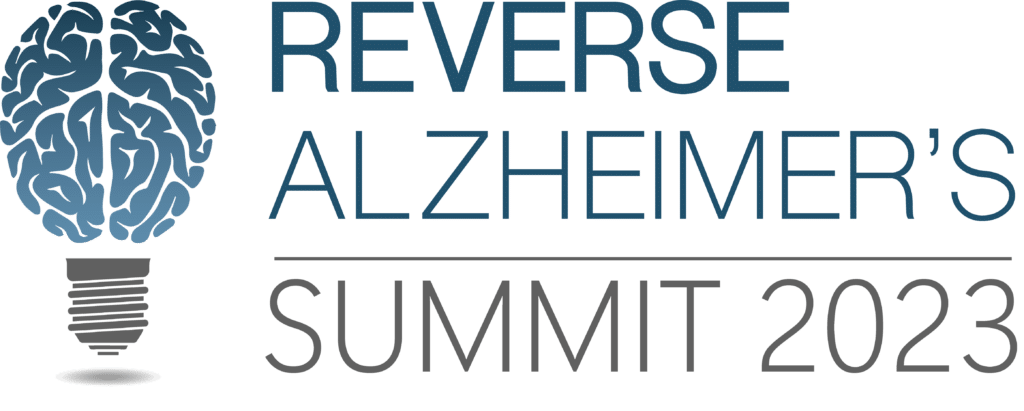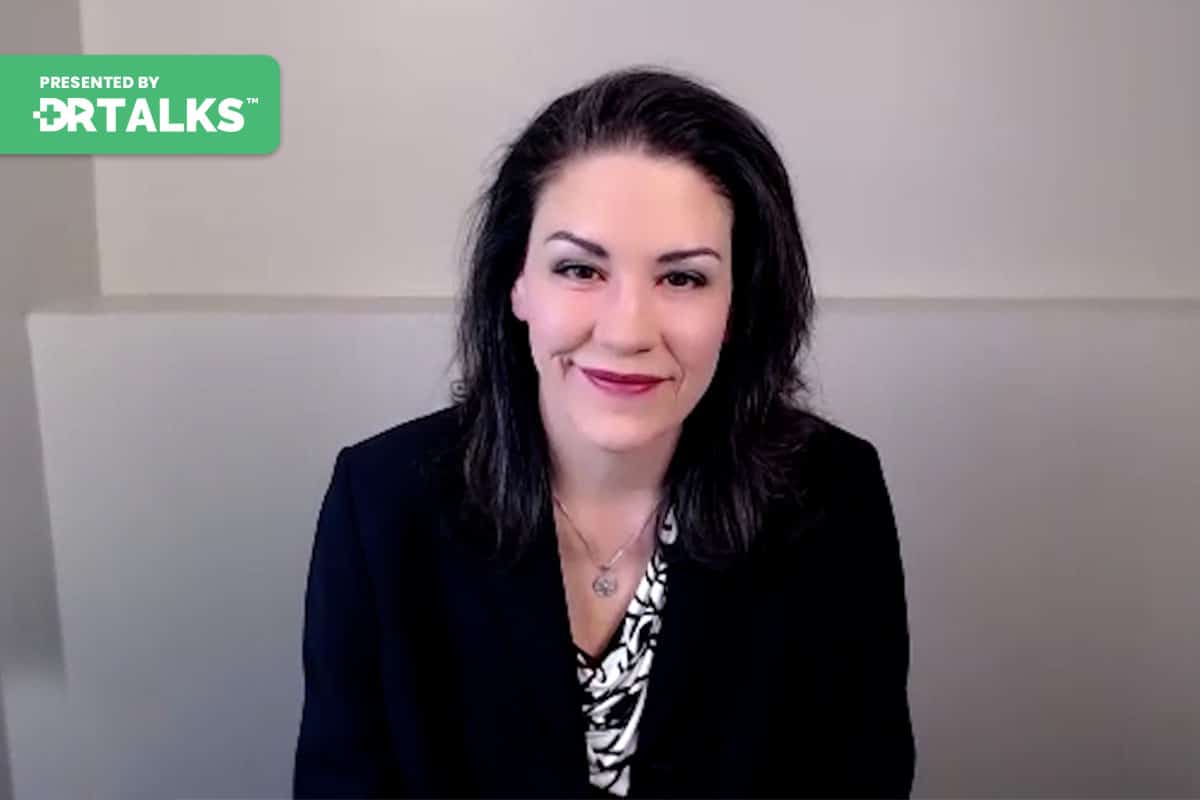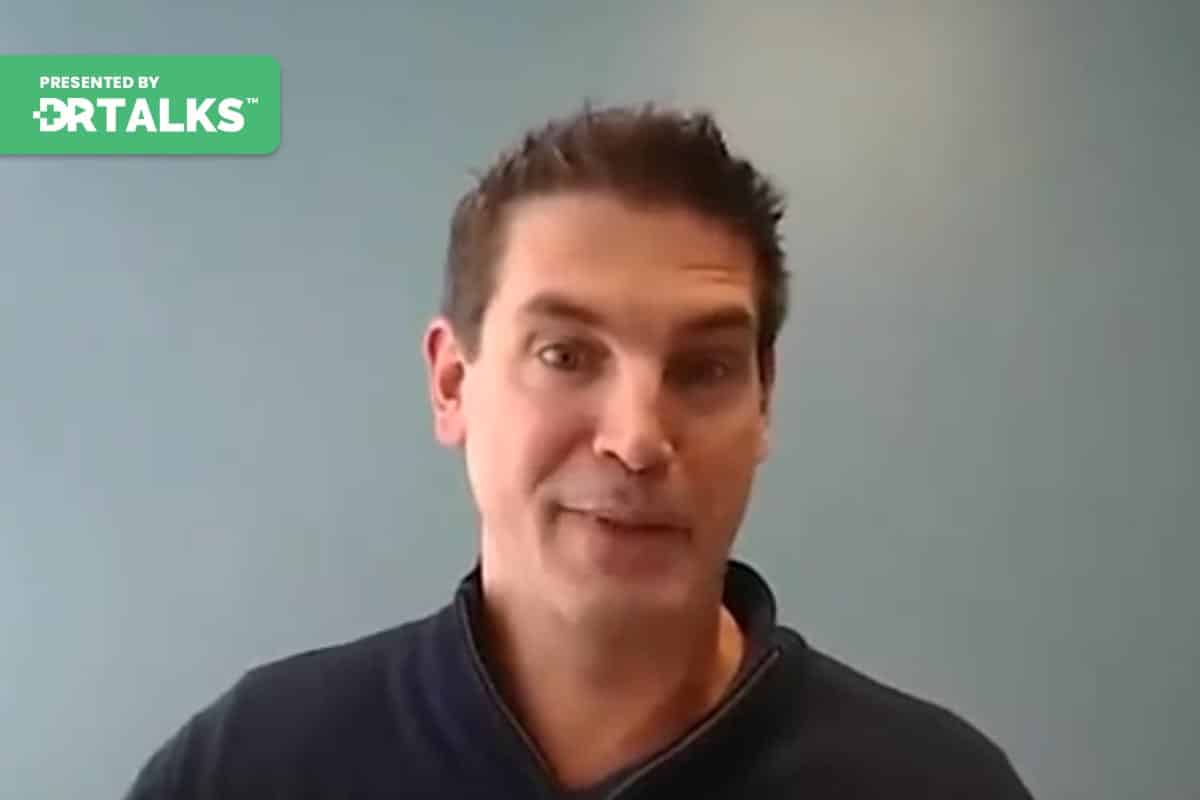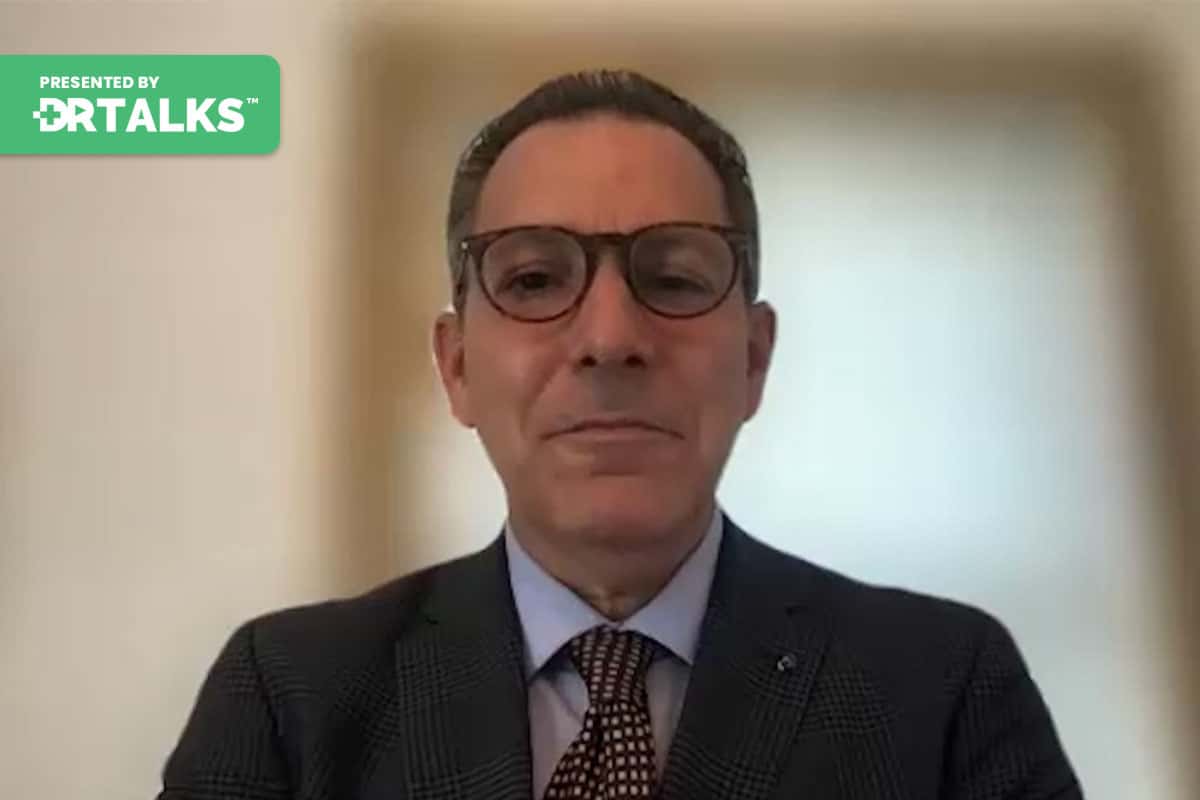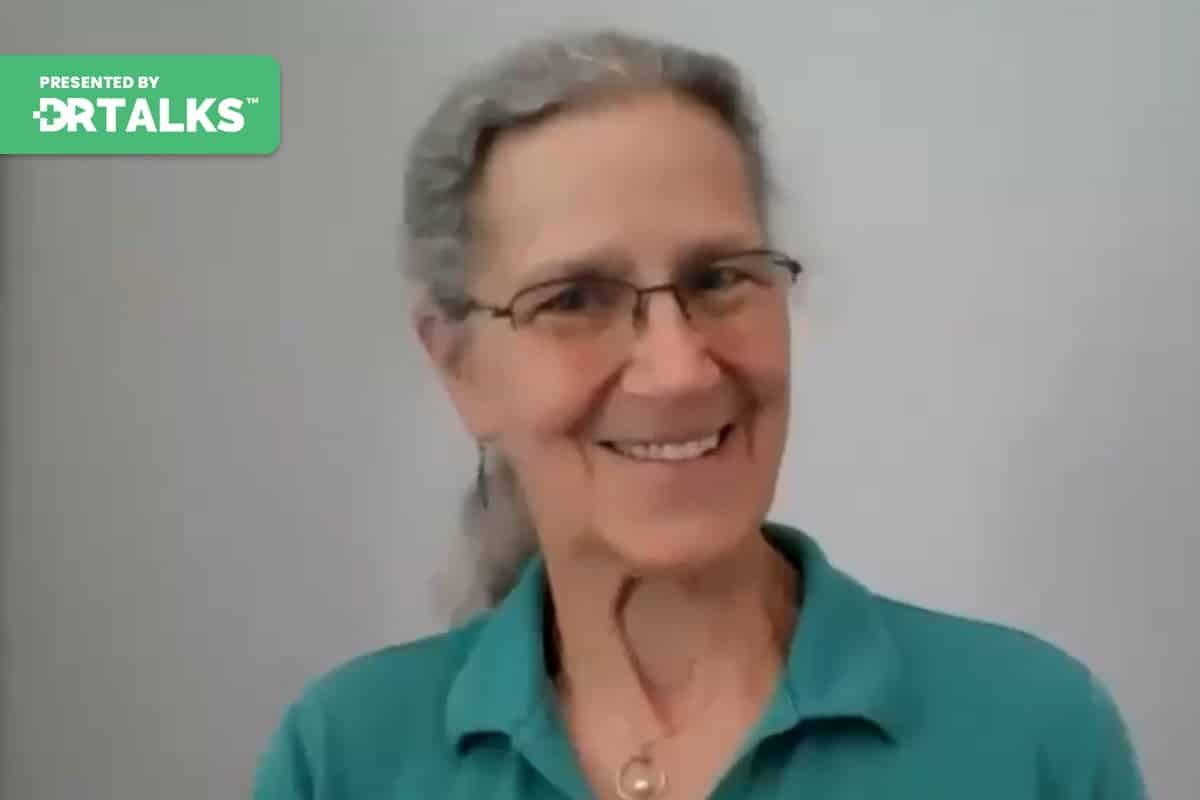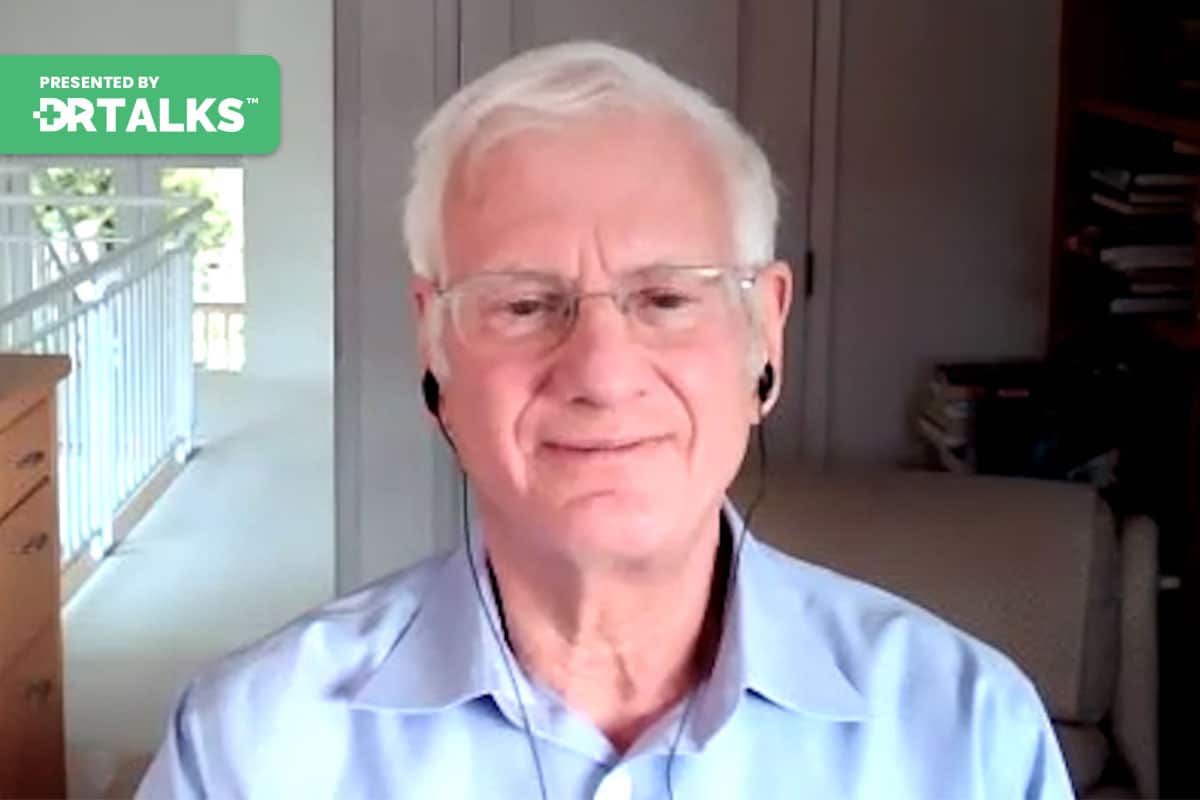Join the discussion below

Dr. Heather Sandison is the founder of Solcere Health Clinic and Marama, the first residential care facility for the elderly of its kind. At Solcere, Dr. Sandison and her team of doctors and health coaches focus primarily on supporting patients looking to optimize cognitive function, prevent mental decline, and reverse... Read More
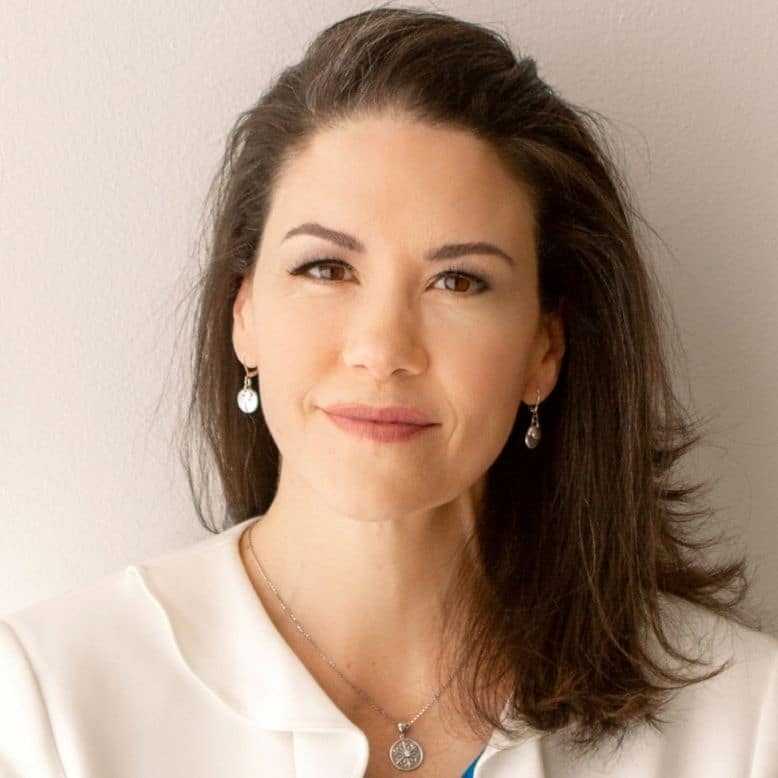
Dr. Wells is a sleep medicine physician. She is on a mission to promote healthy sleep as a foundation for a healthy life. In particular, she helps people with sleep apnea get fully treated without sacrificing their comfort. Through Super Sleep MD, she offers a comprehensive library of self-directed courses,... Read More
Dr. Audrey Wells describes how sleep benefits the brain and what makes sleep healthy
- Understand why sleep is important for Alzheimer’s patients and their caregivers
- Learn about sleep apnea and why it is a problem
- Discover treatments for sleep apnea
Related Topics
Alzheimers, Alzheimers Disease, At-home Sleep Test, Bidirectional Relationship, Brain, Brain Health, Confusion, In-lab Sleep Study, Insurance Coverage, Neurodegeneration, Nightmare Disorder, Parasomnias, Parkinsons Disease, Periodic Limb Movement Disorder, Pulse Oximeter, Rem Sleep Behavior Disorder, Restless Leg Syndrome, Sleep, Sleep Apnea, Sleep Disorders, Sleep Management, Sleep Medicine Doctor, Sleep Quality, Sleep RestrictionHeather Sandison, ND
Welcome to this episode of the Reverse Alzheimer’s Summit. I’m your host, Dr. Heather Sandison. I’m absolutely delighted to introduce you to Dr. Audrey Wells. She’s a sleep medicine physician on a mission to promote healthy sleep as a foundation for a healthy life. In particular, she helps people with sleep apnea get fully treated without sacrificing their comfort. Through Super Sleep, M.D., she offers a comprehensive library of self-directed courses, a group coaching program, and a private Facebook community where you can connect with others who are also suffering from sleep issues. There are free educational resources and more on her website, SuperSleepMD.com. Dr. Wells, thank you for joining us. Welcome.
Audrey Wells, MD
Thanks, Heather. I’m happy to be here.
Heather Sandison, ND
So we already started getting into this conversation a little bit before we hit records. I can not wait to share with everyone that I have already learned tips from Dr. Wells here. I just want to go straight to it because I’m so excited to share the things that I have learned. So we were discussing the At-Home Sleep Study versus the Overnight In Sleep Lab versus a Pocket Pulse Oximeter that is easy to find. A lot of people, I think, with COVID, became familiar with the ease of putting one on your finger and testing your pulse ox at home. So these are varying degrees of cost, there are varying degrees of discomfort and sort of coordination and the need for referrals. So I’d love it if we could just kind of compare and contrast them and figure out what are we missing when we maybe do not do that more robust study in a sleep lab.
Audrey Wells, MD
This is a really important point. I’m so glad to spend a few minutes speaking about it. When you think about an in-lab sleep study, the first question that comes to people’s minds is how am I going to sleep with all of these monitoring sensors on my body? And it is a reasonable question because, by the time you are through the hookup, you are sort of wired for sound. There are sensors coming out all over but each of those sensors is important in measuring a different aspect of sleep. And right now it is kind of the full-court press for what we have in looking for sleep disorders of all types and also fine-tuning treatments. But as you pointed out, over the course of the pandemic, home sleep tests came up as a viable option for many folks who are concerned that they have a sleep disorder, in particular sleep apnea. And I kind of like to be distinctive when I talk about the home test. It is actually a home sleep apnea test because that is the only thing that it tests for. It only tests for sleep apnea. Furthermore, it is only really useful if the test is positive. The reason for that is that a negative test could very well be a false negative test. So for a person who has symptoms or risk factors of sleep or sleep apnea, a negative test is not too helpful. And the next step should be going to the In Lab Sleep study. But overall, I think it is a reasonable place to start with testing, particularly if the concern is with sleep apnea.
Heather Sandison, ND
Okay.
Audrey Wells, MD
Go ahead.
Heather Sandison, ND
No, the pulse oximeter.
Audrey Wells, MD
Yes. I was just going to say that before COVID, I think people were sort of familiar with the spot check. So that means the pulse oximeter is put on the finger and oxygen reading is taken and sort of marked in your record and you can buy those for use at home. So a lot of folks who would do that would come to me and say, but my oxygen level is normal. I can not have a sleep disorder breathing problem because my oxygen levels are normal. And the difference with what they are saying and what I would respond with an overnight pulse oximeter that records is that you are measuring your oxygen when you are awake. So your oxygen levels very well can be normal when you are awake but during sleep, it is a different story.
So not only do you have to have a pulse oximeter but you have to have a recording pulse oximeter that is going to measure your blood oxygen levels every few seconds throughout that entire sleep period. Now, the commercially available recording pulse oximeters have some limitations. At this time they are not as accurate as a medical device and so you may see readings plus or minus four percentage points from where it should be and that depends on a lot of factors but just realize there is room for error. Now, what can be helpful is the pattern. So look at the overall pattern of the oxygen levels. Is there great variability during the night or are they quite stable? That may be a good indicator, if more steps need to be taken. But again, you are looking at the big picture, risk factors and symptoms need to be included in that decision-making.
Heather Sandison, ND
Got it. So I want to go back to those sleep-study in a lab. There are things that are missed when we are only looking at pulse ox are only looking for apnea and we are going to dive deep into apnea. But I just want to check this box so that people understand that there are other sleep disorders outside of apnea that we do not pick up if we are doing any of the at-home currently available tests. Is that right?
Audrey Wells, MD
You are right. And a lot of these are sort of asymptomatic or the symptoms are not perceived even if the person who is being studied has a bed partner because presumably, that bed partner is spending most of the night sleeping as well. So an in-lab sleep study gives us a wider window of vision into what might be going on. For example, problems with restless leg syndrome or periodic limb movement disorder are picked up. Parasomnias, nightmare disorder, confusion, all arousal, and even REM sleep behavior disorder, which is a condition that is kind of perceived as acting out dreams but in the sleep lab we can look at particular characteristics that are picked up on the monitoring sensors inconsistent with normal sleep in order or normal REM sleep in order to make that diagnosis.
Heather Sandison, ND
And my understanding is that this condition in particular is associated with Parkinson’s, another neurodegenerative disease. And so getting a really robust sleep study in a sleep lab, if you are concerned about neurodegeneration, has a really high upside, even though it can take, again, some coordination. Potentially a drive to the sleep lab and that sleepy drive home. So getting somebody else to drive you. I’m sure there are a lot of variables that go into getting that done. You need a referral to a sleep medicine doctor like yourself, and then presumably somebody needs to approve that and make sure that it is going to be covered by insurance. So there are a few hoops to jump through, but it sounds like it is definitely worth it.
Audrey Wells, MD
In some cases, it can absolutely be worth it and critical to an accurate diagnosis. It is not uncommon for people to have more than one sleep problem. And so even if a home sleep apnea test is positive for the condition, if treatment ensues but the symptoms are not resolved, then it may make sense to go to an in-lab sleep study, even in that situation. You mentioned insurance, and I’ll tell you that these days it is probably worth a little bit of legwork in advance of going to a sleep doctor to call your insurance company and say, okay, what testing is covered because many insurances require that testing begins with a home sleep apnea test and it is only after that is negative or the symptoms are not resolved that they would have approved in-lab sleep study. And I think it is important to go back to something that I said earlier, which is a question about how am I supposed to sleep with all of that stuff on. And I want to point out that I do a lot to manage expectations when I see someone who has that question because the myth is sort of that you are in the sleep lab to demonstrate a representative night’s sleep, but unfortunately, that is not the case. All I need is a few hours of sleep, four hours preferably 6 hours to make a good diagnosis. And the sensors that are placed on the scalp that monitor brain waves tell me objectively whether a person is awake or asleep. So if you wake up a lot during the night because you are in an unfamiliar place or there are strange noises or the temperature is not the way you like it. I can factor all of that out and just look at the sleep. So that I am making the best diagnosis that I absolutely can give. A pulse oximeter can not tell me if you are awake or asleep. The home sleep apnea test can not tell me if you are awake or asleep. So those types of measurements give me a blind spot and could effectively dilute the data that I’m able to see.
Heather Sandison, ND
Got it. That is really helpful. Okay. So I have been assuming that everyone listening to us understands the importance of sleep when it comes to neurodegeneration and especially Alzheimer’s. But let’s just go ahead and make sure that we have set out the foundation. What do we know about the connection between sleep quality and Alzheimer’s?
Audrey Wells, MD
There are really compelling data showing that there is a bidirectional relationship between sleep and Alzheimer’s disease. What this means is that people who have Alzheimer’s disease, especially as it progresses, have a parallel erosion in their sleep quality. The flip side of the coin also applies if you have poor sleep quality, for example, or insufficient sleep, your risk for Alzheimer’s increases. Not only that but if you are already diagnosed with Alzheimer’s disease poor sleep quality will tend to accelerate the symptom progression. And it is a shame because a lot of people with sleep conditions can be treated not only with medications or CPAP therapy but also with behavioral measures, things that are under your control.
Heather Sandison, ND
What are some of the top behavioral things that you recommend for somebody who is struggling with their sleep?
Audrey Wells, MD
Anybody who is habitually restricting their sleep time is doing themselves a disservice. And I really want to.
Heather Sandison, ND
Wait, does this mean setting an alarm?
Audrey Wells, MD
You know what I mean? It is cutting back on your sleep, so you can get more done during the day or stay up late to have your time. A lot of people have their personal time because the rest of their day is so busy, they wake up early to finish work or pinch their sleep on either end and getting less than what you need but particularly less than six hours is really detrimental to one’s brain. In fact, sleep restriction has been shown to increase the amount of beta-amyloid protein in the brain, even in people who are not diagnosed with Alzheimer’s disease. And this is one of the proposed mechanisms for sleep loss or poor quality sleep as a cause of Alzheimer’s disease. So getting enough sleep is one of the main ways that people can mitigate their risk over time of cognitive decline and dementia.
Heather Sandison, ND
And my understanding of the literature there was that even people in middle age, even thirties, forties, and fifties who are sleep deprived are having an accumulation of beta-amyloid plaques that can be measured in the morning after a night of sleep deprivation. And then when we look at that over time, people who have accumulated sleep deficits or have restricted their sleep for many years have a much higher risk for developing Alzheimer’s later on. Is that right?
Audrey Wells, MD
You are absolutely right. And I like to make the analogy of rust in a steel pipe. If you have water going through the pipe, one night of sleep loss is going to cause little tiny spots of beta-amyloid that can be measured. If that continues with chronic sleep deprivation or chronic poor sleep quality the rust builds up and then you have a problem. So you are right. Even in the fifties and beyond, chronic sleep loss does associate with cognitive decline.
Heather Sandison, ND
So that is a reason right there to prioritize sleep. When someone has sleep apnea or disturbed sleep and they have dementia, even in those mild kinds of earlier stages, what do you recommend that they do? You mentioned medications. I’d love to know what you think of melatonin and other things that people can basically swallow before bed to get better sleep.
Audrey Wells, MD
With sleep apnea, there is no medication so far that has any demonstrated effect on the condition. So in other words, pap therapy, namely CPAP or auto pep, is still first-line gold. Standard treatments for obstructive sleep apnea. And the mechanism is really simple. With sleep apnea, you have the closure of the airway because the tissues in the back of the throat become floppy on multiple levels, and then CPAP acts as an air stent to hold the throat open. So a person is breathing normally during sleep. In the case of folks who are older with maybe some mild cognitive decline if you are diagnosed with sleep apnea, the thing to realize is that treating that condition, in fact treating it fully can slow the cognitive decline.
And even help to recover some of your memory function, your decision-making, and even emotional stability so preservation becomes key in that stage. CPAP is 95 to 100% effective. If you wear it, that is the key. There is a lot of misconception out there about wearing it for four hours versus wearing it overnight. And four hours are just an insurance requirement. But medically speaking, wearing it throughout the entire sleep period is what you want to target. And part of what I do with Super Sleep, M.D., is to help folks overcome psychological reluctance or even physical difficulty wearing CPAP therapy and if CPAP is not ultimately for a person, then I help them to choose a different treatment. And there are some CPAP alternatives that are coming up as very viable treatments.
Heather Sandison, ND
Such as.
Audrey Wells, MD
The main one that is on the tip of everyone’s tongue is the Inspire surgery. This is also known as a hypoglossal nerve stimulator, and there are very specific parameters for who is a good candidate. But just to say a few words about the procedure, it is a surgery where you have a pacemaker sort of device planted in your upper right chest. It is visible from the outside. I wonder if I had thought I had the device here, but it is about this big and about this thick. So it is implanted in the upper chest and then there is an electrode that comes out of the device and it is routed to the nerve that goes to the tongue that causes forward tongue movement. And the device effectively syncs with your breathing during sleep. You can turn it on and off to push your tongue forward. You do have that sensation of forward tongue movement and the idea is that it gets the tongue out of the airway to open up that path for airflow.
There are upper limits to how severe your sleep apnea can be before you are a candidate for this surgery. And there are there is a procedure that is done prior to the surgery to make sure that your chances of success are high. And basically, what I’m talking about is sleep apnea. It tends to be a multi-level airway obstruction. And the Inspire treatment addresses one level may be one level and a half at the base of the tongue. So you want to get some things checked before you sign yourself up for that surgery. But in those who undergo Inspire surgery, it can be very effective for treating sleep apnea fully or even at least partially getting them down into the mild range.
Heather Sandison, ND
Okay, I have so many questions. So the mild range, I want to talk about that because when I see a sleep study come back and I have been using that Watch pad, which is at home, it is a watch plus a ring, and then it somehow magically beams up to a super smart sleep doctor who interprets it and then gets my patient a recommendation and all of it gets covered by insurance. It is been kind of miraculous, but I understand now, after talking to you, the limits of it. My other question is some people come back with mild sleep apnea and no treatment is recommended. And that makes me so nervous as a doctor treating brain disorders and memory loss because I would think that any sort of apnea is indicative of some kind of sleep issue and a lack of oxygen getting to the brain for part of the night, which sounds really scary. So, do you recommend that people maybe get ahead of that with potentially less invasive? Not a surgery and maybe not even a CPAP or an iPad, but some of these positional devices or the oral devices from a dentist or even the mouth tape or the breathe right strip, some kind of nasal strip. Are there other things that you can do that are less invasive, maybe to treat that mild sleep apnea and notice that you are more rested in the morning?
Audrey Wells, MD
Mild sleep apnea is a little tricky. When research studies are done on the different tiers of sleep apnea severity, what is shown is that for folks who have moderate to severe sleep apnea, there is no question that is affecting your brain and your organ systems. And treatment is indicated with mild sleep apnea. The data are less clear. And I want to just point out again that with a home sleep apnea test, the number can be diluted a bit. So you may be dealing with actual moderate sleep apnea. You may be dealing with sleep apnea that is severe in REM sleep, for example. Whenever a person in my practice comes back with mild sleep apnea, I do a big-picture look. What are we working with here? Are we worried about daytime sleepiness? Are they having the cognitive decline that they are worried about Alzheimer’s or Parkinson’s disease or some other form of dementia? Are they trying to lose weight? Is their bed partner complaining of snoring that interrupts their sleep and causes some family friction? So it is all in the context of the patient.
I like to look at the patient rather than the number so much. And as far as sort of looks at other treatments besides CPAP, I think oral appliance therapy, especially for mild sleep apnea, is a very good option. So the oral appliance is a device made by a dentist qualified to deliver sleep, medicine, and care from a dental perspective. The device fits on the upper teeth and the lower teeth. It is custom made and the two pieces engage to bring the jaw forward a bit and thereby open up the airway caliber. So you need to be able to tolerate that but the oral devices, oral appliance devices are really good for mild sleep apnea. Position devices can also be good if the sleep study demonstrates that the majority of airway obstructions occurred when the person was sleeping on their back. So a positioning device can either be a physical bumper like Zouma or Remedy two brands. It is a neoprene belt with a bumper on the back that keeps you from rolling onto your back. We found that tennis balls do not work so well, so that recommendation is a little bit outdated. But now there is a couple of devices that are electric that prevent you from rolling onto your back. So they are worn on the chest or even around the neck, and they are sensitive to your body position and they vibrate when you move on to your back.
So those are options. If you have positional sleep apnea. Breathe right strips and mouth taping have not been shown to be terribly effective. So you do want to make sure your nose is as open as possible. And a big fan of breathing through your nose. Everybody, please, that is the best way to breathe. But you know, the obstruction in obstructive sleep apnea is happening more in the back of the throat, and that is what needs to be addressed. So sometimes a trial of CPAP could be warranted with the idea that if it is really not for you and it did not make your symptoms better then we learned something.
Heather Sandison, ND
So I just want to share a couple of patient stories where I have seen remarkable changes with the CPAP as one of the very few interventions. Recently, I had a patient who came in, actually, it is been about a year now. She came in originally with a MOCA score of six. So on a scale of 30, six is very severe, 30 is perfect, and normal is 26 and over. And by the time we are getting into the tens people are usually pretty dependent on someone else to help care for them. And when we are six, we are losing activities of daily living. This woman was supported by her son, who was very dedicated, and she was living independently from him. So he was not there day-to-day involved in everything that she was doing. Just ten months later, her sleep box score was 13. It had gone up and he said to me, I have got my mom back. She was using utensils in the kitchen. She got the carrot peeler out and started peeling a carrot. She put the peeler in the dishwasher. She knew where things were.
And, you know, this was her son. So he remembered her as somebody who could cook. And she had lost that ability for several years, if not more. So she had been really having a severe decline for a while. And because they were living separately, he was not there to help her with her diet. He had all the supplements laid out, but he was not sure she was taking them all. She was getting some exercise, but not that much because she did not want to get lost in her community and she was kind of at that stage. And what he did was he really made sure she used her CPAP and that was what made the difference. Now, she was eating more vegetables, of course, a little bit more because he was buying that. But it wasn’t a supercontrolled diet. She did not get into ketosis, which I’m a fan of and had recommended.
She basically got on her bioidentical hormone replacement and she got on the CPAP and that is what made the difference. And the neurologist told her this was not possible, told them that this reversal of cognitive decline was not possible and he just did not believe it. But the son was describing how she was engaging people in the grocery store again. She’d been very social and she had been so withdrawn during this time of decline. And so he found that he was experiencing her and her experience of her life, had just really transformed for the better because of this intervention. And it just illustrated to me, I have tears in my eyes, like seeing her and realizing how much better she was doing. And it just illustrated to me the importance of good, high-quality sleep and the treatment of sleep apnea.
Audrey Wells, MD
I love stories like that. And fortunately for me, I get to hear them often. I want to say a few words about what happens with one apnea event. Do we have time for that?
Heather Sandison, ND
Absolutely. Please. Okay.
Audrey Wells, MD
I think this kind of highlights sleep apnea as a breathing disorder. More than a sleep disorder. I think when it gets characterized as a sleep disorder, it is a little bit under-recognized for the problem that it is. So recognized sleep, that when you have an airway obstruction during sleep, it needs to be at least 10 seconds long to even count. So for people watching, try holding your breath for 10 seconds and see how slowly the time passes. So that is counting just one apnea or hypoxia, as it were, which is a complete airway obstruction or a partial airway obstruction. So you are not breathing, you have choked off your airway. When that happens, your blood oxygen levels go down because you are not getting air to your lungs anymore. And at some point, and it is a little different for everybody, your brain will start getting irritated by that because your brain is seeing low oxygen levels and it doesn’t like it. So then sleep is not possible because it is a threat. You have to wake up to open up your airway.
Now, these awakenings are typically not full consciousness, so the person who is affected does not always recognize what is going on. And similarly, the bed partner may not either, but your oxygen levels go down. You have to disrupt your sleep by waking up to breathe and bring your oxygen levels back up. For someone who has maybe mild to moderate, let’s say 15 airway obstructions per hour of sleep, that is a hundred airway blockages in one night with oxygen levels going down and your brain exposed to that, your brain on red hot alert to this threat of your sleep. So when a person experiences that and again, that is on the border between mild and moderate sleep apnea, it makes sense that the CPAP, which is just giving that gentle air pressure stent and allowing a person to breathe normally and sleep normally results in an improvement in all kinds of mood, daytime functioning, interpersonal relationships, memory. So the power of sleep is impressive. And I think it is so under-recognized as a tool. In my mind, good sleep is good medicine. Full stop.
Heather Sandison, ND
I could not agree more. Now there is a little bit of a myth about weight and sleep apnea. I think a lot of people and certainly, I came to this work assuming that if you were underweight or had normal weight, you could not have sleep apnea. And what I have seen is the opposite. I have very thin older women who do not snore, and who have significant sleep apnea. So what is the connection with weight? And the other thing that has happened is patients tell me, oh, no, no, I’m not going to get a CPAP. I’m not going to worry about that because I have a plan to lose weight and it is going to go away once I lose weight. So can you speak to this connection between weight and apnea?
Audrey Wells, MD
I can and if I miss something remind me because I’m really interested in this. I’m also awarded an obesity medicine and this is another bidirectional relationship. So the intention to lose weight to get rid of sleep apnea is a good intention. But the fact is untreated sleep apnea blocks your ability to lose weight. And there are multiple mechanisms for this. So when somebody wants to try that, I make sure and make a follow-up appointment with them in about three to six months to check in and see how they are doing. The truth is disrupted. Sleep increases your hunger hormone and reduces your satiety hormone. Not to mention by the end of the day, your willpower is kind of short and that makes going to the cupboard for the cookies and the cakes. And, you know, for me, it is salty treats. All of those things will sabotage weight loss. 20% of people with obstructive sleep apnea are of normal weight. This speaks to the multifactorial factorial risks for obstructive sleep apnea. Fat deposition in the airway, in the tongue, and under the neck are all risks for sleep apnea, but so is age, and so is sex. In other words, men have a higher risk. Post-menopausal women have a higher risk.
There are probably a lot of familial or genetic conditions that we do not understand that contribute to sleep apnea. And one of the reasons that we know this is that for quite a number of folks losing weight, even getting to a normal BMI from a significantly elevated BMI, does not always correct sleep apnea. For example, I have mild sleep apnea right now, and I am in the normal weight category. I think I knew that I was going to get sleep apnea when so many of my family members got diagnosed, some by me. But this is something that is not just related to weight and also weight loss doesn’t always correct it. So we got to look deeper ahead.
Heather Sandison, ND
That is really helpful. I want to cover a big topic for me and us. I treat most of my clients well. Most of my patients are those who are suffering from dementia and their caregivers come in with them. And one of my big messages is that you can not serve from an empty vessel. You need to put your oxygen mask on first. And for care partners supporting someone who is struggling with dementia, sleep is often the thing that gets sacrificed. Sleep, exercise, diet but sleep in particular because as you mentioned, it is when people, maybe a care partner has that moment to themselves at the end of the day after someone else has gone to sleep. And also, as you also mentioned, Alzheimer’s affects sleep. And so some people as they go through that progression of disease, they are only sleeping six hours. Maybe they go to bed at 8 p.m. and now they are up at 3 a.m. And so now their care partner is worried they are going to get out of the house, get lost, or they are going to get hurt somehow in the house, or they are going to be confused or agitated. And so quickly you can see how care partners struggle to get enough sleep. Do you have advice for care partners who are listening?
Audrey Wells, MD
I think this is such an important thing to discuss and I love the visual of trying to serve from an empty vessel because sleep deprivation will suck your energy dry really fast, even sleep interruption is tough to deal with. There are a few tips that I’ll give, and then I want to tell you that in the e-book that I have written, I have really listed these out in more detail so that people can kind of pick and choose what might pertain to them. As I mentioned before, getting enough healthy sleep. So just doing a survey about what sleep symptoms a person might have that could indicate an underlying sleep condition is important for the caregiver as well as the person that they are caring for. Beyond that, we are looking at elements of good sleep hygiene. One thing that I think is really important to focus on is keeping a fixed wake-up time seven days a week. This is actually more important than bedtime, as it turns out, for kind of resetting our circadian rhythm every day. So that fixed wake up time can be moved a little bit earlier. If you want to have your me time, it is best to do it first thing in the morning when your brain is fresh and you are able to enjoy it more. And if you are able to get bright light exposure even from electronic screens if need be, even coupling that with exercise, that is a powerful signal for wake and that will help you to be more alert during the day. So fixed wake-up time and then a wind-down time at the end of the night can be really helpful. So in that case, you are going to look at your light exposure. Dim lights are best for reducing electronic screen time and especially eliminating electronic screens at least an hour before you want to go to bed. Not only will it help with your melatonin production, your natural melatonin production, but it also gives you an emotional break. You know, there is a lot of emotional agitation that can come with electrical electronic screen use at night. Doom Scrolling or Facebooking or social media or whatever.
Heather Sandison, ND
Or watching the news.
Audrey Wells, MD
Yes, the news is another thing. So you want to allow your emotions to kind of slow down and stop as well, make sure your bedroom is cool. Sometimes it is nice to take a hot bath before bed. Not only for the relaxation benefit, but what it does is it opens up your circulation to your extremities, your hands, and your feet, and that distribution then allows your core temperature to come down just a little bit, which is a signal for sleep. So that is a quick hack for getting to sleep. You can take it one step further by putting an ice pad on your face, and an ice tuck that is very calming. It engages the person’s parasympathetic nervous system and can help a person fall asleep.
Heather Sandison, ND
Do you have a recommendation in terms of the temperature to keep your bedroom at for good sleep? And I have even seen these like pads that are cool that you can put under your mattress, under your sheets. Do you find that those help with sleep quality?
Audrey Wells, MD
They do for sure and you know, it is a little different for everyone. I think some people are more sensitive, some people are not in general. The recommendation is to have your bedroom temperature less than 70 degrees, preferably down in the 65-degree range. And it is a matter of personal preference. The cooling mattresses, and cooling pillows. I see a lot for some of my patients who are going through menopause. That can be especially helpful for hot flashes and things. Or if there is a discrepancy in your bed partner preferences versus your preferences that can help mitigate the temperature a bit. But in general, you want to be around 65 degrees for optimal sleep.
Heather Sandison, ND
And then I’m so curious, I’m a little bit nervous about what you are going to say because I’m wearing one right now. But what do you think about the devices that track sleep? What do you think?
Audrey Wells, MD
So I’m wearing an Aura ring too. I think you probably saw and I love wearable devices for highlighting sleep. So our brains get a little bit of gamification, I think with these wearable devices. I do not know about you but I like looking at my sleep so that when I wake up in the morning. I’m like, what did I get? And sometimes I’ll have a really strong sensation that I was awakened from a dream. And I like to check and see if the Aura reports that as well. A little bit of caution. These devices are not super accurate at sleep stages, although I do think that is getting better. But they are fairly accurate at determining when you got to sleep and when you woke up. The quantity of sleep is one way that they are useful. I think it is just interesting. It highlights sleep for people. It gets them to pay attention. So I love that.
Heather Sandison, ND
I have a friend who works at Aura and he said that over 90% of people who have the ring check the app the next day, which is crazy high for any of the wearables and the adoption rate is high. But then this sustained experience of using it is also higher than most other wearables, which is interesting. Yeah, go ahead.
Audrey Wells, MD
I’m not surprised. I think that it gets to that part of our brain that wants to be validated, that wants to get data about ourselves. It is a way of self-knowing. And it is in a sense, in a time during sleep when we are otherwise unconscious. So it is a little window into ourselves, which is fascinating.
Heather Sandison, ND
What about the oxygen saturation measurements on the ring? Is that going to give us anything of value?
Audrey Wells, MD
Not really. I would not put too much weight on that at all, except to say that if it is terribly abnormal, then yes, inquire. And so you would.
Heather Sandison, ND
Do something about it.
Audrey Wells, MD
But with these wearable devices, one of the challenges is that the data that was looked at when they studied the device is usually for normal subjects. So they are basically just confirming what we already know about normal people without lung disease or heart disease. And so it is just not where it should be and there is too much room for error. I mean, even the amount of space between my skin and the device itself is higher than I would like for an accurate reading. And they use a different mechanism. You might see a green light or a red light. That way of measuring is different from what a medical-grade pulse oximeter uses. So I would not hang my hat on abnormalities. But if you have other symptoms and the big picture is consistent with something else that might be going on, then yes, get that checked out.
Heather Sandison, ND
Okay. Let’s talk about those symptoms really specifically, because I think I know what you mean, which is basically daytime sleepiness or waking up, getting out of bed, and feeling unrested. Then can you go into more of what other symptoms you have alluded to, mood kind of changes and irritability, but what are other signals in terms of symptoms that someone might be experiencing that would make them prioritize seeing a sleep doctor or at least asking their primary care provider about investigating further?
Audrey Wells, MD
Great question. So if you are having frequent and prolonged awakenings during the night, that could be problematic. It takes about 3 to 5 minutes of continuous wakefulness during the night to kind of register in your memory. So if you are having more than half a dozen of those at night if there is a bed partner report of movement during sleep or acting out dreams that should prompt a visit with a sleep physician. Interestingly, there are a lot of medical conditions that worsen with untreated sleep problems. For example, if high blood pressure that it is difficult to control if you are on escalating doses or need multiple medications to control blood pressure, come see somebody like me. Atrial fibrillation is a big one.
Now, in general, a diagnosis of AFib will earn you a visit to the sleep doc because there is so much overlap between that condition and sleep apnea. And if your sleep apnea is not treated, it makes your AFib worse or more difficult to treat. Diabetes, weight loss. Those are other conditions that are exacerbated by problems with sleeping. Acid reflux during the night. I could go on, as you can tell. Sleep is just one of the foundations of good health in some sense. If you were to go and get a sleep study, it is never a bad idea because at least you have confirmed it is normal or established a baseline if everything is negative. So, I do not think everybody deserves a sleep test, although it is a joyous experience. But I think that whenever there is reasonable suspicion that something’s going on, look at the sleep and see if you can just get the low-hanging fruit.
Heather Sandison, ND
Right? Absolutely. Well, I’m going to wish everyone a good night tonight. It is good quality sleep because we have learned certainly how important it is. And also, if you are not getting sleep, please reach out to your primary care provider, and get that referral, for the sleep medicine. I think Dr. Wells has done a great job explaining why this is just so important. Whether your caregiver or care partner looking to prevent dementia or actively experiencing cognitive decline. This is a really important piece of the puzzle. Dr. Wells, I want people to know where they can find out more about you. And I know we mentioned your super sleep m.d dot com. You also have the group coaching program. Can you describe a little bit what that is about and why people typically sign up for that?
Audrey Wells, MD
Yeah, the group coaching program is to have more interpersonal interaction with others struggling with the same sleep condition, and with me. There is just something to be said with the community and kind of looking at each other even if it is through a screen. So it is to help people get supported with their CPAP use or with implementing practices that support good sleep in the face of a busy life. All of these things need to be managed. These things need to be supported. And sometimes the best way to do that is by interacting with others. So that is what group coaching is meant to do.
Heather Sandison, ND
This has been an amazing service. Thank you so much for all you do and thank you so much for sharing your time with us today.
Audrey Wells, MD
My pleasure.
Downloads
